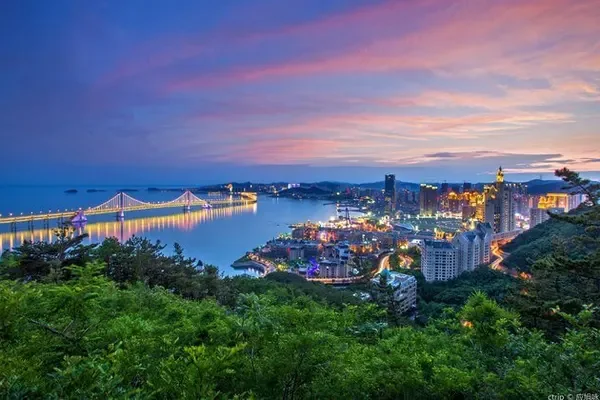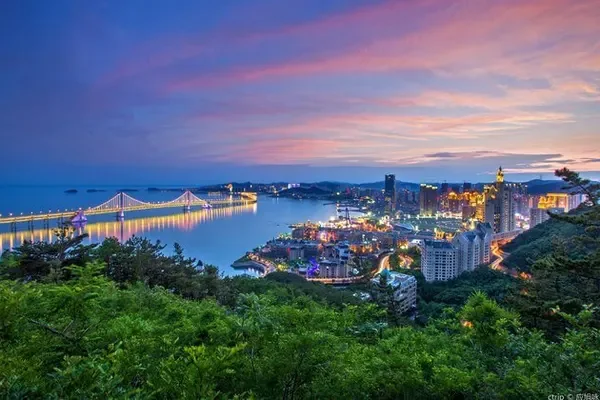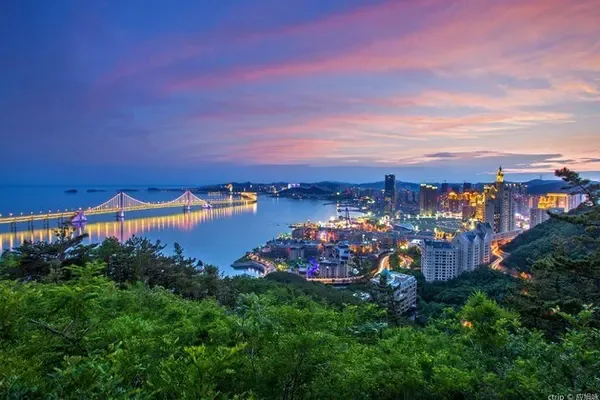The second day of the Chuan Zhi Ding tour is destined to be a relatively hard day because you have to go from Xindu Bridge to Daocheng Yading, and you have to trek 420 kilometers on the western Sichuan mountain road all day. Although it was difficult, the sightseeing and browsing items of the day were colorful and interesting.
At 7 o'clock in the morning on September 18, 2021, the reporter and his party set off from the Xinduqiao Yuxin Hotel where they stayed last night and embarked on a journey. The bus is driving in the continuous mountains in western Sichuan, and the scenery outside the window is pleasant. I saw Tibetans driving yaks, cattle and sheep grazing peacefully, rivers and brooks gurgling, large clouds floating in the blue sky constantly changing, alpine vegetation lush and lush, and beautiful scenery all the way.
In the car, the tour guide Zhong Lingling said that although the focus of our sightseeing that day was to go to Litang, the first city on the plateau, the hometown of Ding Zhen, before and after that, we will pass through Yajiang, the hometown of matsutake in China. The Scissors Bend known as the 18th bend of the road, the Kazila Mountain at an altitude of 4718 meters, the Rabbit Mountain at an altitude of 4696 meters, the Haizi Mountain at an altitude of 4500 meters, and the Red Grass Wetland after entering the Daocheng Yading and many other scenic spots will definitely make people feel happy. You get unforgettable rewards for the fatigue of a long drive. After hearing what Xiao Zhong said, everyone was full of expectations.
At 08:15 in the morning of the same day, after more than an hour's drive, the bus first passed Yajiang. Yajiang, which means "Yaquka" in Tibetan and "hekou", is located in the southern part of Ganzi Tibetan Autonomous Prefecture, Sichuan, at 29.03-30.30 north latitude and 100.19-101.26 east longitude. It borders Kangding County in the east, Muli County of Liangshan Prefecture in the south, Litang County in the southwest, and Daofu and Xinlong Counties in the north, covering an area of 7,637 square kilometers. It used to be one of the important ferry crossings of the Yalong River in history.
Here is known as the hometown of mushrooms in China, and it is rich in matsutake village. China is the world's largest producer and exporter of matsutake, and the main producing areas are Sichuan, Yunnan and Jilin. Sichuan matsutake is mainly distributed in 12 counties of Yajiang, Kangding, Daocheng, Jiulong and Danba in Ganzi Tibetan Autonomous Prefecture; among them, Yajiang matsutake is favored by domestic and foreign countries because of its high yield, large size, fine meat, good color, and delicious taste. Yajiang collects more than 1,000 tons of matsutake every year. Every year, businessmen from Japan, South Korea and other countries travel thousands of miles to Yajiang to buy matsutake.
At 09:15 on the same day, the reporter and his party first arrived at the Jianziwan Mountain Observation Deck overlooking the 18th Bend of Tianlu, which is nearly 4,100 meters above sea level. Jianziwan Mountain, also known as Jianziwan Liangzi and Jianziwan Mountain, belongs to Shaluli Mountain. It stands on the west side of Xianggezong Township, Yajiang County, Sichuan Province. It runs from northwest to southeast. It is the watershed between Yalong River and Jizhugou. It is called "Bolanggong" in Tibetan, which means the top of the mountain with fog all day long. Its Tibetan name is "Jamana Zha", which means Yangzi Mountain Pass. The mountain pass is 4659 meters above sea level, and it is one of the highest mountain passes on the 318 National Highway passing through the Kham area. The artistic conception with a panoramic view of thousands of mountains and valleys, and a taste of the ancient charm of the ancient tea-horse road.
Jianziwan Mountain is an important pass on National Highway 318. The winding road, circling up to the pass at an altitude of 4,500 meters, is both a challenge and an enjoyment for self-driving tours. Overlooking the mountain road when it comes down from the viewing platform, I can't help but be amazed. The characters "Eighteen Bends of Tianlu" are inlaid on the winding mountain road, and clouds like white gauze float from the sky, making the Tianlu sometimes disappear. Now, like a fairyland, I can't help but sigh the hardships of the road workers.
There is also a stone carving on the viewing platform of this pass, which is engraved with the words "Rizhao Jinshan". From here, you can overlook Gongga Mountain, the highest peak in Shu. The treacherous high sky clouds, accompanied by the tall and straight green pines in front of you, add to the magnificence, mystery and remoteness of Gongga Mountain.
After finishing the sightseeing of the 18th bend of Tianlu, the reporter and his party boarded the bus and continued on their way. At 10:20, we came to the second sightseeing spot on the way to Litang, the Kazila Mountain sightseeing platform at an altitude of 4718 meters. Looking around, it is full of green and the scenery of rolling mountains is very magnificent. Groups of grazing yaks wander around people looking for food leisurely.
Kalazi Mountain Scenic Spot is located at the junction of Litang County and Yajiang County. It is a famous high mountain in eastern Sichuan. The color of the layer is light, reaching to the horizon, as if walking on the 'road to heaven'. Kazila Mountain is a mountain, but it doesn't feel like it is a mountain. It seems to be a beautiful pasture, which makes people feel relaxed and happy. The beautiful scenery makes people linger and forget to look at it enough.
After lunch, an important stop on Chuanzhiding's itinerary for the day is Litang Letong Ancient Town, which is known as the first city on the plateau and the city of white cranes. The thousand-year-old Tibetan village here is the highest county in the world, and it is also one of the must-see places when traveling on the Sichuan-Tibet line. I don’t know if we will meet again in the next life? Litang met but was a teenager.
It is precisely because of Ding Zhen, a young man from Litang, who conquered the whole world with his innocent smile, and his simple and kind nature, so that more and more people like him, and they are more and more curious about the place where he grew up: Litang, which makes people from Many people from all over the world traveled thousands of miles to Litang just to see Ding Zhen's hometown.
When I came to the Qianhu Tibetan Village in Litang, the city of sky, the tour guide Zhong Lingling specially arranged for Yang Lianglei, a staff member of Litang Scenic Area, a Tibetan boy to be the guide. He first led the reporters to visit the most famous scenic spot here, that is, the Renkang Ancient House in Letong Ancient Town in Zhaizhong, because it is the birthplace of the seventh Dalai Lama.
Walking into a street in the ancient town with a strong ethnic flavor, the houses on both sides are all Tibetan-style buildings, one next to the other. Coming to the end of the alley, facing Litang is the best-preserved Renkang Ancient House Family Temple. It is located in Chema Village, Gaocheng Town, Litang County, Ganzi Prefecture. The family temple is on the second floor and the bottom is pure. Tibetan-style architecture, the family temple covers an area of about 2,518 square meters. It was built in the middle of the 16th century and has been around for more than 400 years.
Entering the ancient house, in the atmosphere filled with the fragrance of ghee in the dim candlelight, listening to the commentator Yang Lianglei's eloquence: In more than 400 years, the Renkang Ancient House has successively given birth to thirteen great living Buddhas with high morals and high prestige. Among them, there are seven famous ones. Therefore, the seven wooden balls made of sandalwood that can be seen on the door of Renkang's house are actually the "pestle" of the Tantric deity, which means auspiciousness and surpasses everything else. Symbol of demons.
These seven are: the seventh Dalai Lama, the third Jebtsundamba, the largest national teacher of Mongolia, Losang Danbi Nyima, the ninth Pabala, the master of Jambaling Temple in Qamdo, and Shewala in Qamdo Living Buddha Yixi Jigme, Dengbi Announcement, Zaya Lama Luoden Xirao, Luori Living Buddha Luorong Dengbijie Village, Litang Temple's 20th Khenpo Geden Gyatso, so many famous living Buddhas were born in the same house, This is also very rare in Tibet. The Renkang Ancient House is famous for it and has become a holy place of worship for Tibetan Buddhism. There is a Tibetan saying that if you go to Tibet to worship through Litang, if you don’t pay homage to the Renkang Ancient House, you have never really been to Tibet. The status of Renkang Ancient House is extraordinary.
Looking back at historical records, as the line in the poem of the sixth Tsangyang Gyatso, "Pure white crane, please lend me your wings, it will not fly to far away places, only fly around Litang, and then fly back", foretells The next time the Seventh Dalai Lama was born in Litang, on January 9, 1708, the Seventh Dalai Lama was born in Renkang’s house in Chema Village, Litang County. Lion's milk, heralds the birth of a Buddha-like sage, and all the water stored in the home turns into milky white milk.
After the birth of the 7th Dalai Lama, many Tibetan letters naturally appeared on the cornerstone of the lion breast stigma. On the side of the cornerstone, there were also some patterns of tantric instruments (vajra and vase), which were still clearly identifiable. On January 21, the eighth year of Emperor Yongzheng of the Qing Dynasty (1730 A.D.), the Dalai Lama left Litang by order and was escorted by 2,000 soldiers led by Ren Guorong, the chief military officer of Chongqing Town, Sichuan. On February 3, the Seventh Dalai Lama lived in Huiyuan Temple in Daofu.
In July of the twelfth year of Emperor Yongzheng of the Qing Dynasty (AD 1734), the Dalai Lama was escorted to Tibet, accompanied by Zhang Jia Guoshi along Litang, Batang, Mangkang, Qamdo and other places. There are many cultural relics in the former residence. The blue-glazed double dragons presented by Emperor Qianlong to the Seventh Dalai Lama are bright in color, blue and white porcelain from the Xuande Year of the Ming Dynasty, and five Thangka paintings of Benjiao. Hometown misses his self-portrait sculpted by his relatives and newcomers.
In addition, the tambourine instruments used by the seventh Dalai Lama, the empty robes, and the Han-style bronze mirrors of the Ming and Qing dynasties are all preciously collected by the descendants of the Renkang family and displayed in the ancient house. The Litang Kham Museum is for people to watch today.
After finishing the visit to the Renkang Ancient House, the reporter and his party took a sightseeing bus and followed the village streets and alleys in the Qianhu Tibetan Village to the second famous scenic spot in Litang: Qingqing Kele, the largest Yellow Sect temple in the upper Tibetan area of Letong Ancient Town. Temple, continue to look up.
The temple, also known as Litang Temple, was founded in 1580 by the third Dalai Lama Sonam Gyatso. It is the oldest and largest Tibetan Buddhist Yellow Sect temple in Kham. Changqing Keer is a transliteration of Tibetan, "Changqing" means Maitreya Buddha, the future Buddha, "Chun Keer" means Falun, and "Changqing Keer" means Maitreya Dharma wheel, which symbolizes the constant rotation of the Dharma wheel and the wonderful truth forever. It is the largest temple of the Yellow Sect of the Gelug Sect in Kham, and is known as the "Holy Land of Buddhism in South Kham".
On the same day, when we visited Changchun Keer Temple in Litang, the reporter and his party were fortunate enough to see five butter flowers, which were very beautiful. Xiao Yang, the guide, said that they are usually invisible, because this year is the 100th anniversary of the founding of the Communist Party of China and the 70th anniversary of the founding of Ganzi Tibetan Autonomous Prefecture. Anniversary, so be lucky to see it.
Butter flower is a special form of sculpture art. Jueanqinba in Tibetan means "fifteen offerings", also known as "butter flower". It is a superb handmade oil sculpture art with ghee as the raw material, with characters, flowers, birds, animals, trees and other people and things as the theme. It has a long history. In the two important scenic spots in Litang, Yang Lianglei's vivid and vivid explanation of the whole process left a deep impression on the reporter and his party.
Finally came to King Gesar Square in Litang. Litang was the ancient battlefield and big camp where the Tibetan national hero King Gesar protected the people and fought against the invading enemies more than 1,000 years ago. His relics and beautiful legends are here. everywhere. Litang, the descendant of King Gesar, is also known as the "hometown of equestrianism". The nation on horseback is also the settlement of what is often called "Kangba men". Therefore, King Gesar Square, which was built later, has a strong Ethnic style.
In the center of the square stands a statue of King Gesar on a leaping horse and whipping his whip. Behind it is a mural showing a magnificent historical picture scroll. The characters and scenery images in the mural are distinctive and extremely vivid. Now it is a gathering place for leisure and entertainment of all the people, old and young. At night, crowds dance with sleeves and form a beautiful landscape of Litang. As the largest cultural and landmark square in Litang, King Gesar Square is like the symbolic meaning of Tianfu Square to Chengdu.
The reporter and his party finished the sightseeing of Qianhu Tibetan Village in Litang and continued to move forward. At around 16:00 in the afternoon, they passed Tuer Mountain with an altitude of more than 4,696 meters. His majestic appearance is hard to see...
After passing the Rabbit Mountain, which is shaped like a rabbit ear, you will come to the Haizishan Nature Reserve. Here is the largest ancient ice body relic on the Qinghai-Tibet Plateau, Daocheng Haizi Mountain Nature Reserve, with an altitude of 3600-5020 meters and a radius of 3287 square kilometers.
It is famous for the "Daocheng Ancient Ice Form", which is the relic of the ancient ice form left to mankind by the orogeny of the Himalayas. It is empty and lonely, and there are many strange rocks.
It's a pity that when we passed here, it was catching up with the heavy rain, the water was pouring out of the window, the fog was soaring into the sky, and the vision was basically zero distance, and we didn't see any beautiful scenery. Maybe it is the reward given by God. When we passed Haizi Mountain and Tuer Mountain one after another on the way back from Daocheng Yading, the sky was already blue and white, and the sun was shining brightly. Therefore, pictures of Tuer Mountain and Haizi Mountain were finally left. beautiful pictures. Of course, this is something for later.
At 17:38 in the afternoon, the reporter and his party entered Daocheng from Litang and came to the Red Grass Wetland Scenic Area, the last stop of the day. It is located in an inconspicuous small pond by the road of Sangdui Town, 28 kilometers north of Daocheng County. Every autumn, it is covered with red aquatic plants, hence the name. Maybe it's not the best season yet, and the red grass scene in front of me is not very red yet.
The red grass wetland on the side of the road service area, if it is not autumn, the scenery here will never attract people's attention. A water and grass beach the size of a football field, with granite glacial boulders randomly scattered in the water and on the shore Placed there, a few piglets were feeding on the grass by the water, and the mud was dumped on the ground.
But at the end of September and the beginning of October every year, the scenery will be completely different. The aquatic plants in the water seem to be ignited overnight, and clusters and clusters of red grass rush towards the water in a very ostentatious way, which is the most gorgeous deep red. There are no gaps in the grass, and the water embraces the blue sky, white clouds, and distant mountains, adding more colorful patches to the red grass beach.
At around 20:30 that night, after more than ten hours of trekking throughout the day, the reporter and his party finally arrived at their destination on the second day of Chuan Zhi Ding’s itinerary. building. The most anticipated trip to Daocheng Yading Scenic Area is about to begin. (Photo: Feng Ganyong)



